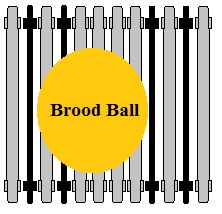Limit the use of CombForms™
between brood frames to no more than 25%.
One well known rule of beekeeping is "Don't split the brood". CombForms™ allow passage of workers, queens and drones so they can be placed between brood combs when being used to guide the hive to expand, but bees do this best when encouraged to make gradual changes. This means a weak hive or a nucleus hive with three frames of brood can be encouraged to produce one more frame of brood by placing one empty frame between two comb forms just at the edge of the brood ball. If you have six frames of brood you can encourage them to produce additional brood by adding an empty frame between two comb forms on both sides of the brood ball.
One CombForm™ is inserted within the brood ball to correct misshapen comb
Additional CombForms™ are used outside the brood ball in the areas of misshapen comb.


